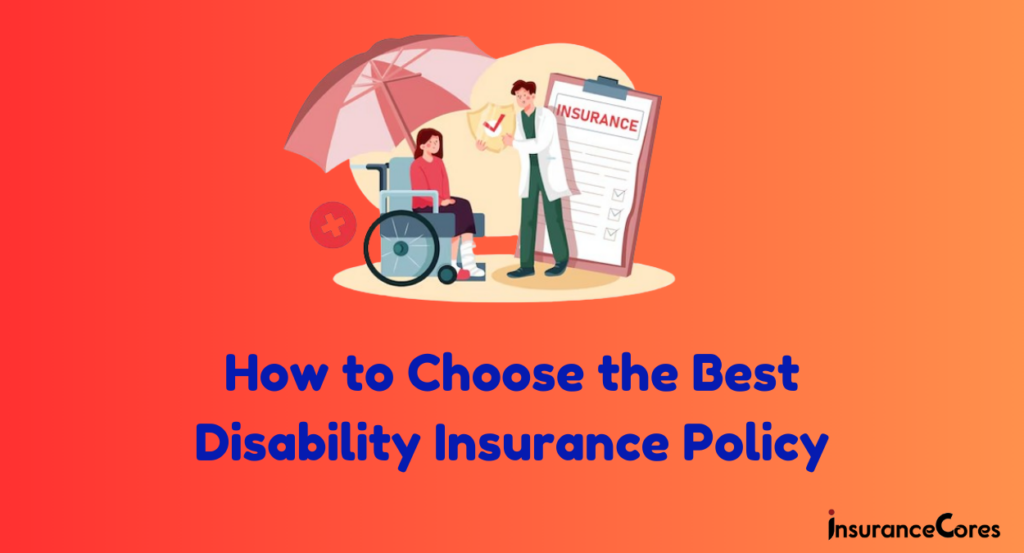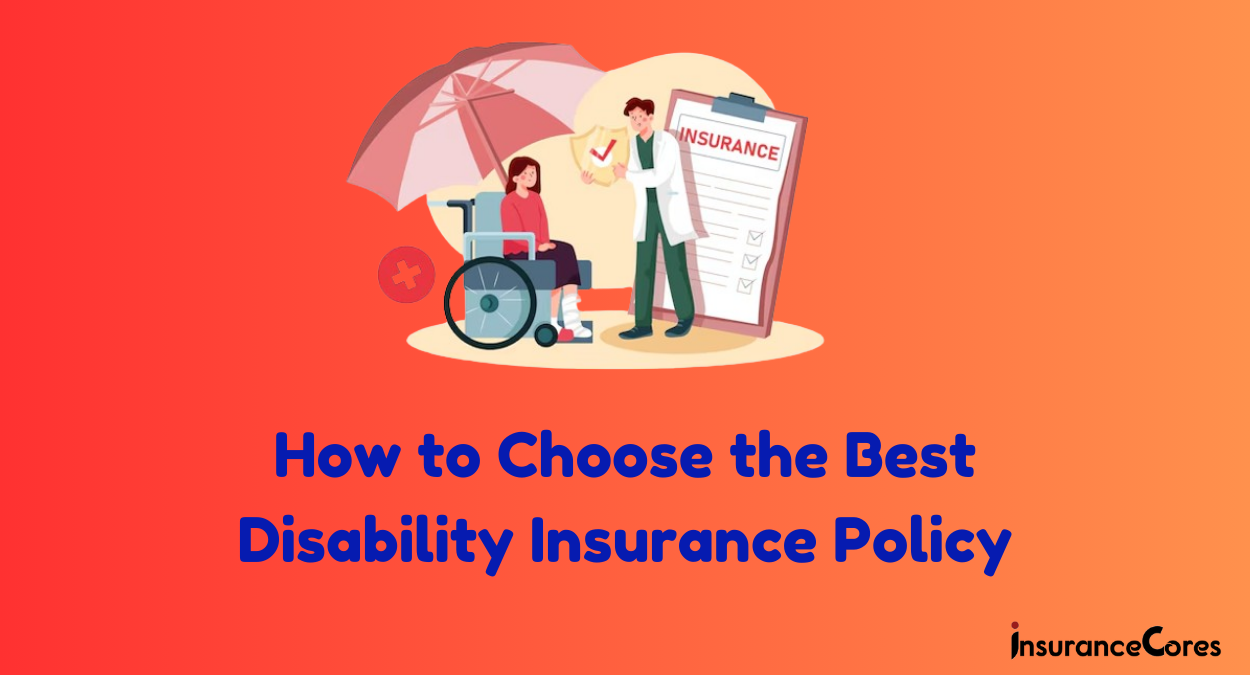Disability insurance is a critical component of financial planning that many individuals overlook. It provides a safety net in the event that you are unable to work due to injury or illness, ensuring that you can maintain your standard of living and meet your financial obligations. In this comprehensive guide, we will delve into the various aspects of disability insurance, offering insights and advice on how to choose the best policy in 2024.

Understanding Disability Insurance Policy
Disability insurance is designed to replace a portion of your income if you become unable to work due to a disabling condition. There are two main types of disability insurance: short-term disability (STD) and long-term disability (LTD). Each serves a different purpose and provides different levels of coverage.
Short-Term Disability Insurance (STD)
Short-term disability insurance provides coverage for a limited period, typically ranging from a few weeks to six months. This type of insurance is intended to cover temporary disabilities that prevent you from working for a short duration, such as recovery from surgery or a serious illness.
Key Features of STD:
- Coverage period: Usually 3-6 months
- Waiting period: Typically 0-14 days
- Benefit amount: Often 60-70% of your pre-disability income
Long-Term Disability Insurance (LTD)
Long-term disability insurance, on the other hand, offers coverage for extended periods, potentially until retirement age. This insurance kicks in after your short-term disability benefits expire and provides financial support for more severe and long-lasting disabilities.
Key Features of LTD:
- Coverage period: Several years to age 65 or retirement
- Waiting period: Usually 90 days or more
- Benefit amount: Often 50-60% of your pre-disability income
Why Disability Insurance is Important
The likelihood of experiencing a disability that impacts your ability to work is higher than many people realize. According to the Social Security Administration, more than one in four 20-year-olds will become disabled before reaching retirement age. Disability insurance provides essential financial protection, ensuring you can cover your living expenses, medical bills, and other obligations even if you are unable to work.
Factors to Consider When Choosing Disability Insurance Policy
Selecting the best disability insurance policy involves evaluating several key factors to ensure it meets your needs and provides adequate protection. Here are the most important considerations:
1. Definition of Disability
One of the most crucial aspects of a disability insurance policy is how it defines “disability.” Policies can vary significantly in their definitions, which impacts when and how benefits are paid.
Own Occupation vs. Any Occupation:
- Own Occupation: This definition pays benefits if you are unable to perform the duties of your specific job.
- Any Occupation: This definition only pays benefits if you are unable to work in any job for which you are reasonably qualified by education, training, or experience.
Tip: For better protection, look for a policy with an “own occupation” definition, especially if you have a specialized profession.
2. Benefit Amount
The benefit amount is the percentage of your pre-disability income that the policy will pay. Most policies offer benefits ranging from 50% to 70% of your income. When evaluating policies, consider your monthly expenses and financial obligations to determine how much coverage you need.
Tip: Ensure the benefit amount is sufficient to cover your essential expenses, including mortgage/rent, utilities, food, and medical bills.
3. Benefit Period
The benefit period is the length of time the policy will pay benefits if you become disabled. Shorter benefit periods typically result in lower premiums, but they may not provide adequate long-term protection.
Tip: Opt for a policy with a benefit period that covers at least until you reach retirement age to ensure long-term financial security.
4. Waiting Period (Elimination Period)
The waiting period, also known as the elimination period, is the time you must wait after becoming disabled before benefits begin. Common waiting periods range from 30 to 180 days.
Tip: Choose a waiting period that aligns with your emergency savings. A longer waiting period can lower your premiums, but ensure you have enough savings to cover expenses during this time.
5. Policy Premiums
The cost of disability insurance policy premiums varies based on factors such as age, occupation, health, and the specifics of the policy. While it’s important to find a policy that fits your budget, don’t sacrifice essential coverage for lower premiums.
Tip: Consider policies that offer a balance between affordability and comprehensive coverage.
6. Non-Cancellable and Guaranteed Renewable
Policies that are non-cancellable and guaranteed renewable provide added security, ensuring that your policy cannot be cancelled, and premiums cannot be increased as long as you pay your premiums on time.
Tip: Look for policies with these features to ensure long-term stability and predictability in your coverage.
7. Riders and Additional Features
Many disability insurance policies offer optional riders that can enhance your coverage. Some common riders include:
- Cost of Living Adjustment (COLA) Rider: Adjusts your benefit amount for inflation.
- Future Increase Option (FIO) Rider: Allows you to increase your coverage as your income grows without medical underwriting.
- Residual Disability Rider: Provides partial benefits if you can work part-time due to a disability.
Tip: Evaluate the riders available and consider adding those that offer valuable protection based on your circumstances.
Steps to Choose the Best Disability Insurance Policy
Choosing the best disability insurance policy involves a systematic approach to ensure you find the right coverage for your needs. Here are the steps to guide you through the process:
Step 1: Assess Your Needs
Begin by evaluating your financial situation and identifying how much income you need to replace if you become disabled. Consider your monthly expenses, debt obligations, and lifestyle to determine the appropriate benefit amount.
Step 2: Research Providers
Research disability insurance providers to find reputable companies with strong financial ratings and positive customer reviews. Look for insurers that specialize in disability insurance and have a history of reliable claims payments.
Step 3: Compare Policies
Obtain quotes and compare policies from multiple insurers. Pay attention to the key features such as definition of disability, benefit amount, benefit period, waiting period, and available riders. Use online tools and consult with insurance agents or brokers to facilitate comparisons.
Step 4: Evaluate Policy Terms
Carefully review the terms and conditions of each policy. Understand the exclusions, limitations, and any circumstances under which benefits might be reduced or denied. Ensure that the policy language is clear and comprehensive.
Step 5: Consider Your Budget
Determine how much you can afford to spend on premiums without compromising essential coverage. Balance the need for comprehensive protection with the cost of premiums to find a policy that fits within your financial plan.
Step 6: Consult a Professional
Consider consulting with an insurance professional or financial advisor who specializes in disability insurance. They can provide personalized advice, help you navigate complex policy terms, and ensure you make an informed decision.
Step 7: Purchase and Review Regularly
Once you choose a policy, complete the application process and purchase your coverage. Regularly review your policy to ensure it continues to meet your needs, especially if your financial situation or occupation changes.
Must Read:
- Quick info Automobile Industry Insurance: Best Way’s to Safeguarding Vehicles and Beyond in 2024
- What is Temporary Car Insurance? Best Way’s to Flexible Solution for Short-Term Needs in 2024
FAQs
1. What is the difference between short-term and long-term disability insurance?
2. How much disability insurance coverage do I need?
4. Can I get disability insurance if I have a pre-existing condition?
5. What is an elimination period in disability insurance?
Conclusion
Choosing the best disability insurance policy is a crucial step in protecting your financial future. By understanding the different types of coverage, evaluating key factors, and following a systematic approach, you can find a policy that provides the security and peace of mind you need. Remember to assess your needs, research providers, compare policies, and consult with professionals to make an informed decision. With the right disability insurance in place, you can safeguard
